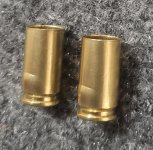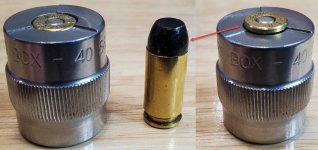9mm Luger Case
I refer to this as a pregnant shell case.
There is a bulge at the base of the case which is quite noticeable.
I appears to me that the case is not chambered all the way when firing.
Which could happen with a full automatic firearm.
OR
There is a defect in the barrel chamber.
I see this fairly often on range brass.
Sorry I couldn't get a good pic from the side.
Any idea what causes this?
I refer to this as a pregnant shell case.
There is a bulge at the base of the case which is quite noticeable.
I appears to me that the case is not chambered all the way when firing.
Which could happen with a full automatic firearm.
OR
There is a defect in the barrel chamber.
I see this fairly often on range brass.
Sorry I couldn't get a good pic from the side.
Any idea what causes this?


